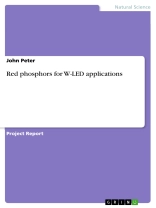Project Report from the year 2015 in the subject Physics – Optics, ST Anne’s College Of Engineering And Technology (St. Anne’s College of Engineering and Technology, Panruti, Tamilnadu, India), language: English, abstract: Trivalent rare-earth-ion-activated molybdate based phosphors have attracted great attention for solid-state lighting applications by virtue of their long lifetimes, and efficient luminescence property. The rare-earth ions are represented by a partly filled 4f shell that is completely shielded by 5s2 and 5p6 orbitals. Therefore, emission transitions provide sharp intense lines in the optical spectra [1, 2].
The use of rare-earth element-based phosphor, based on ‘‘line-type’’ f–f transitions, can narrow the emissions to the visible range, resulting in high efficiency and a high-lumen equivalence. In recent years, a flourishing care is concentrated on Li3Ba2Gd3-x(Mo O4)8 host matrix for luminescent ions in the interest of their excellent chemical and thermal stability and favourable luminescence characteristics compared to the sulfide- and nitride-based materials.
Moreover, these are environmentally friendly as no toxic gases like sulphide are given out. Li3Ba2Gd3-x(Mo O4)8 occur in monoclinic crystal system with space group C2/c in a disordered structure [3].
For this research paper, a series of Li3Ba2Gd3–x Prx (Mo O4)8 (x = 0.01, 0.03, 0.05, 0.07and 0.09 mol) and Li3Ba2Gd3–x Smx (Mo O4)8 (x = 0.02, 0.04, 0.06, 0.08 and 0.10 mol) red phosphors were synthesized by conventional solid state reaction method.
The use of rare-earth element-based phosphor, based on ‘‘line-type’’ f–f transitions, can narrow the emissions to the visible range, resulting in high efficiency and a high-lumen equivalence. In recent years, a flourishing care is concentrated on Li3Ba2Gd3-x(Mo O4)8 host matrix for luminescent ions in the interest of their excellent chemical and thermal stability and favourable luminescence characteristics compared to the sulfide- and nitride-based materials.
Moreover, these are environmentally friendly as no toxic gases like sulphide are given out. Li3Ba2Gd3-x(Mo O4)8 occur in monoclinic crystal system with space group C2/c in a disordered structure [3].
For this research paper, a series of Li3Ba2Gd3–x Prx (Mo O4)8 (x = 0.01, 0.03, 0.05, 0.07and 0.09 mol) and Li3Ba2Gd3–x Smx (Mo O4)8 (x = 0.02, 0.04, 0.06, 0.08 and 0.10 mol) red phosphors were synthesized by conventional solid state reaction method.
Language English ● Format PDF ● Pages 16 ● ISBN 9783668043046 ● File size 1.8 MB ● Publisher GRIN Verlag ● City München ● Country DE ● Published 2015 ● Edition 1 ● Downloadable 24 months ● Currency EUR ● ID 4500051 ● Copy protection without











